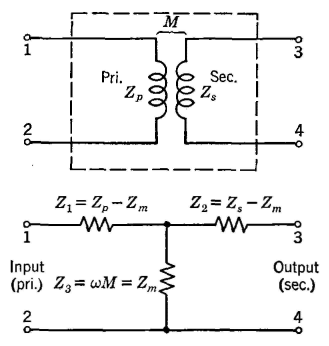| Electrical Communication is a free textbook on the basics of communication technology. See the editorial for more information.... |

|

Home  Electric Networks Electric Networks  Image Impedances Image Impedances |
|||||






|
|||||
Image ImpedancesFour-terminal transducers are used for passing electric energy from one part of an electric system to another. Often it is desired that the transducers draw maximum possible signal power from the preceding part of the system and pass it on to the following part of the system. Ordinarily, this cannot be done under the condition of conjugate impedances, and hence the conditions of the second power transfer theorem must be met. The image impedances of a transducer are defined1 as the "impedances which will simultaneously terminate each pair of terminals
of a transducer in such a way that at each pair of terminals the impedances in both directions are equal." An unsymmetrical, unbalanced T network is shown in Fig. 18, the network being unsymmetrical because Z1 does not equal Z2. It is desired to find the two image impedances ZI and ZI' that
will satisfy the definition previously given. If this is accomplished, then maximum power transfer would occur from the transducer to the impedance (or from the impedance to the transducer) at either set of terminals. The equations for the image impedances can be written for the conditions specified in the definition. Thus, the input impedance at terminals 1-2, with image impedance ZI' connected at terminals 3-4 (but with ZI not connected), is
The input impedance at terminals 3-4, with image impedance ZI connected at terminals 1-2 (but with ZI' not connected), is
When these two equations are solved, the image impedances are found to be
and
It is also possible to write equations for the image impedances of a π section; or the π section can be transformed into a T section, and equations 43 and 44 then used. An investigation will disclose that unsymmetrical networks have impedance-transforming properties and that they can be used for impedance matching.
|
|||||
Home  Electric Networks Electric Networks  Image Impedances Image Impedances |
|||||
Last Update: 2011-06-06







